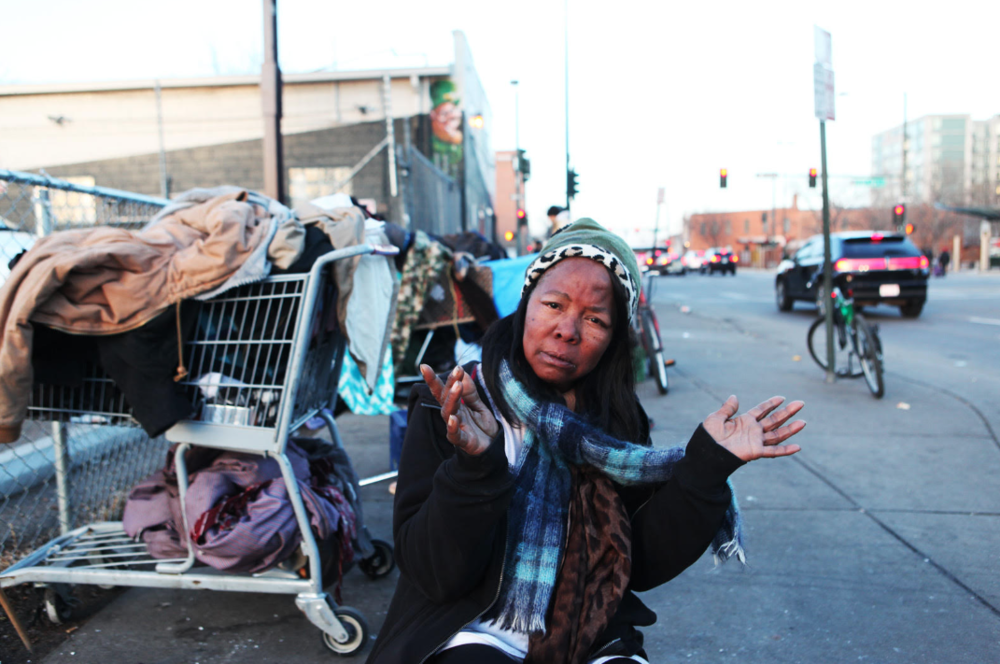Curb-side Charity
Though some on the streets call these sidewalk donations a blessing, others fear the charity does more harm than good.
Story and photo by Andrew Kenney
 Diane Lorene Cox says sidewalk donations are a blessing.The Denver Rescue Mission is asking that would-be Samaritans stop giving food and supplies directly to people on sidewalks near its facility in the Ballpark neighborhood.
Diane Lorene Cox says sidewalk donations are a blessing.The Denver Rescue Mission is asking that would-be Samaritans stop giving food and supplies directly to people on sidewalks near its facility in the Ballpark neighborhood.
“We encourage people to have that heart of service and want to come down, to find places to volunteer,” said Alexxa Gagner, director of public relations for DRM. “But coming down and handing out sandwiches is just not the most dignified way to treat the people that are experiencing homelessness.”
The mission operates a shelter and community center not far from Coors Field, its neon cross glowing near the intersection of Broadway and Park Avenue. It is a neighborhood of extreme income disparities, a historic center for supportive services that has seen massive redevelopment as the rebranded Ballpark neighborhood.
On any given evening, dozens of people sit or stand for hours on the sidewalks around the mission, many with their belongings arranged on blankets or in shopping carts. Some are waiting for mealtime or a bed at DRM, but others say they stay out on the streets. Occasionally, patrons of nearby bars pick their way along the narrowed sidewalks.
Spontaneous street-side donations arrive in a variety of ways. Recently, someone ordered a pizza to be delivered straight to the sidewalk, Gagner said. Churches and youth groups come with food. One group regularly hands out home-cooked burritos.
“It’s a blessing,” said Diane Lorene Cox, who stays outside the mission. She can’t stomach most of the meals served there, she said. She sees the sidewalk meals as a reflection of the help she gave others during her youth in New York.
“I helped people, and they helped me,” she said.
A woman named Jo, who declined to give her last name, said that donors often bring material supplies too.
“It’s socks, it’s hats—it’s a help,” she said. “They know that we need a lot of help that [local nonprofits] can’t provide.” Two men who declined to give their names said that donations come as often as a few times a week.
Sal Garophalo, who is staying in a hotel while waiting on permanent housing, is familiar with many people along the block. He is skeptical that ad-hoc donations are ultimately beneficial.
“It’s enabling,” he said, just after greeting Cox with a warm hug. He often sees people who receive sleeping bags, jackets, and other items sell them within hours or days, he said. He believes that nonprofits are more effective than untrained donors in distributing goods and food.
“I think they have a deeper discretion,” he said.
Community center impact
The Rescue Mission’s new Lawrence Street Community Center (LSCC) was intended to offer relief to people living on the streets. The Ballpark Neighborhood Association sued to block its opening; BNA leadership has argued that lower downtown is host to an unfair share of services.
On a recent afternoon, the LSCC had a substantial crowd inside. With its new facilities, DRM is serving an average of 1,500 meals per day, compared to 1,000 before. But, of course, many people remain along the nearby streets.
“We can’t control people who are outside of our facility. We provide the services, and we encourage people to use them,” Gagner said. “We really didn’t know exactly what the Lawrence Street Community Center would do, in terms of people on the other side of our block and along Park Avenue. Historically, there has been a population of people on those blocks.”
The mission sees itself and other charitable organizations as best equipped to serve those people. Spontaneous and ad-hoc donations can “condition” people, said Gagner, and discourage them from coming inside for services.
The mission’s attempt to minimize those donations is not a reaction to pressure from neighborhood groups, she said.
“We haven’t heard specifically from the X-Y-Z business or individual that it’s a problem—but we want to be a good neighbor,” she said, describing nonprofits as “a better way to serve” than spontaneous donations.
“Anything we can do to keep our street clean, and encourage people to use our services, is going to help make a positive environment.”
She said that people wishing to help can find many opportunities with the LSCC, which needs about 50 volunteers per day. ■
